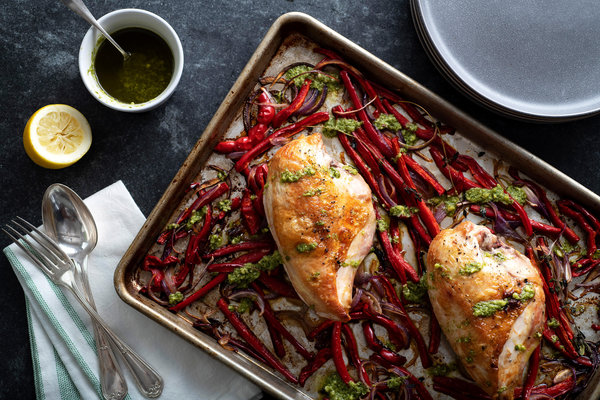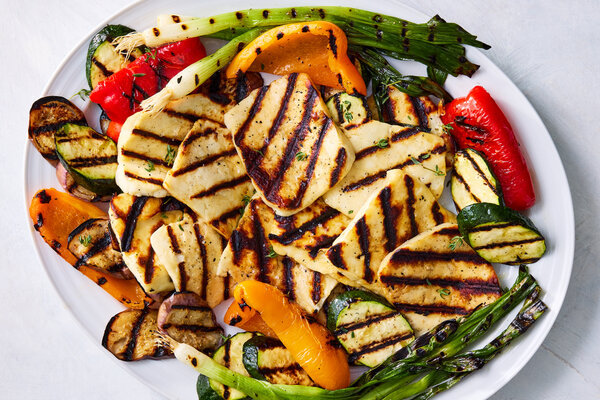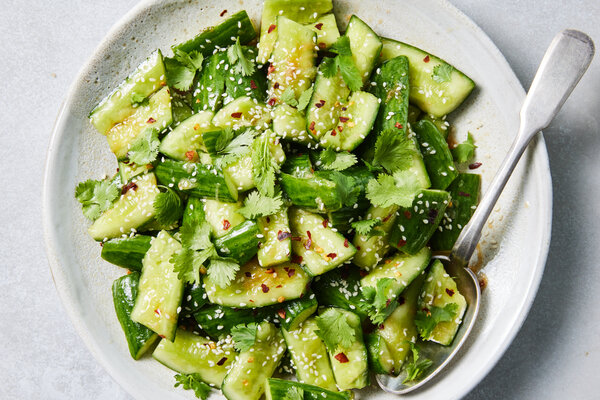Melissa Clark will teach you cook times and techniques so you can throw just about anything on a pan and have dinner.
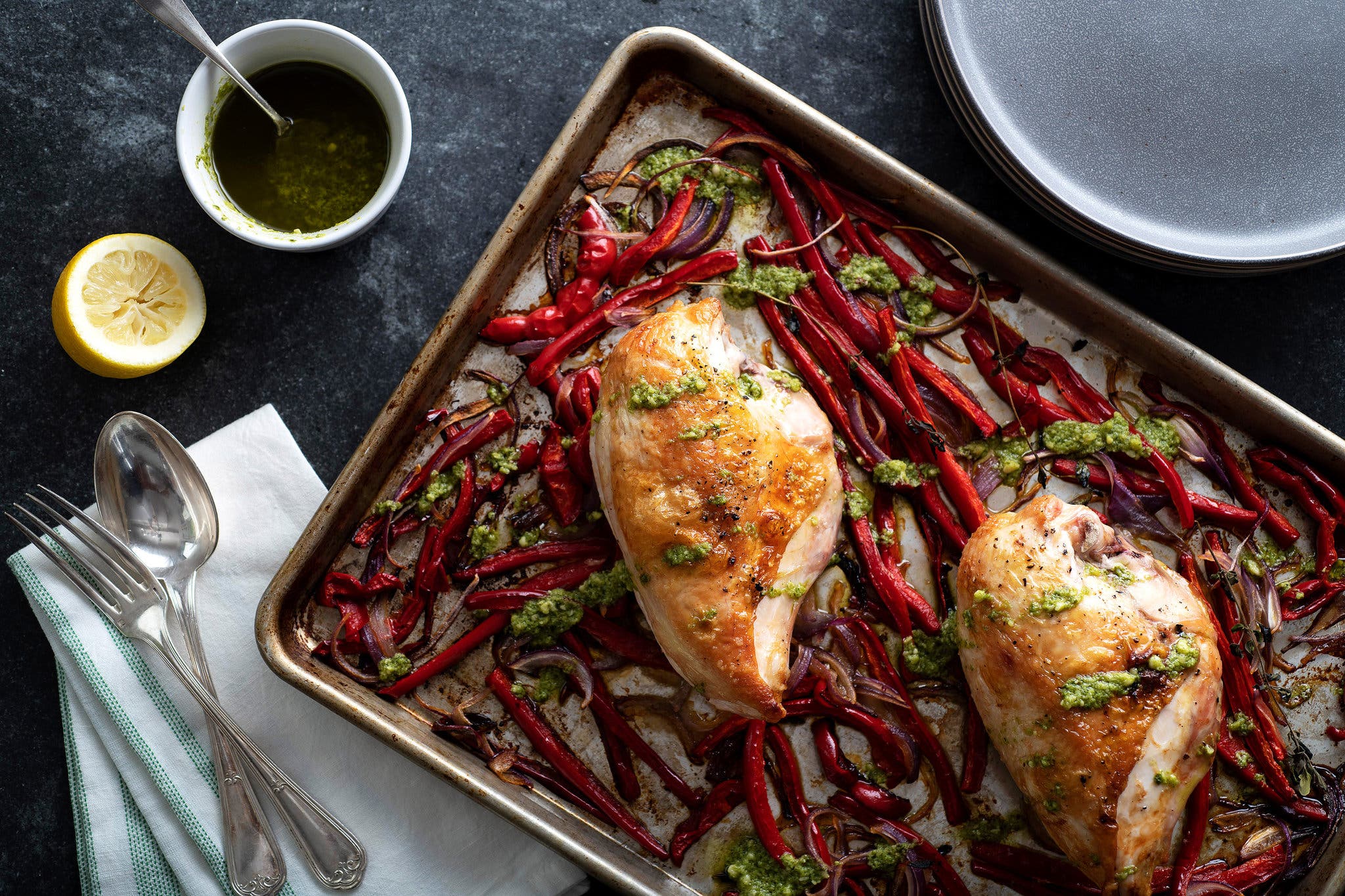
Chicken breasts are less likely to dry out on a sheet pan when they’re bone-in and skin-on.Karsten Moran for The New York Times
[This article was originally published on Sept. 24, 2018.]
A sheet pan takes the concept of a one-pot meal and flips it onto a pan. It saves time, makes cleanup easier, and doesn’t require expensive equipment or fancy ingredients. Just start with your protein of choice, then add vegetables, fat and flavorings, and roast at high heat until everything is golden brown. Here’s how.
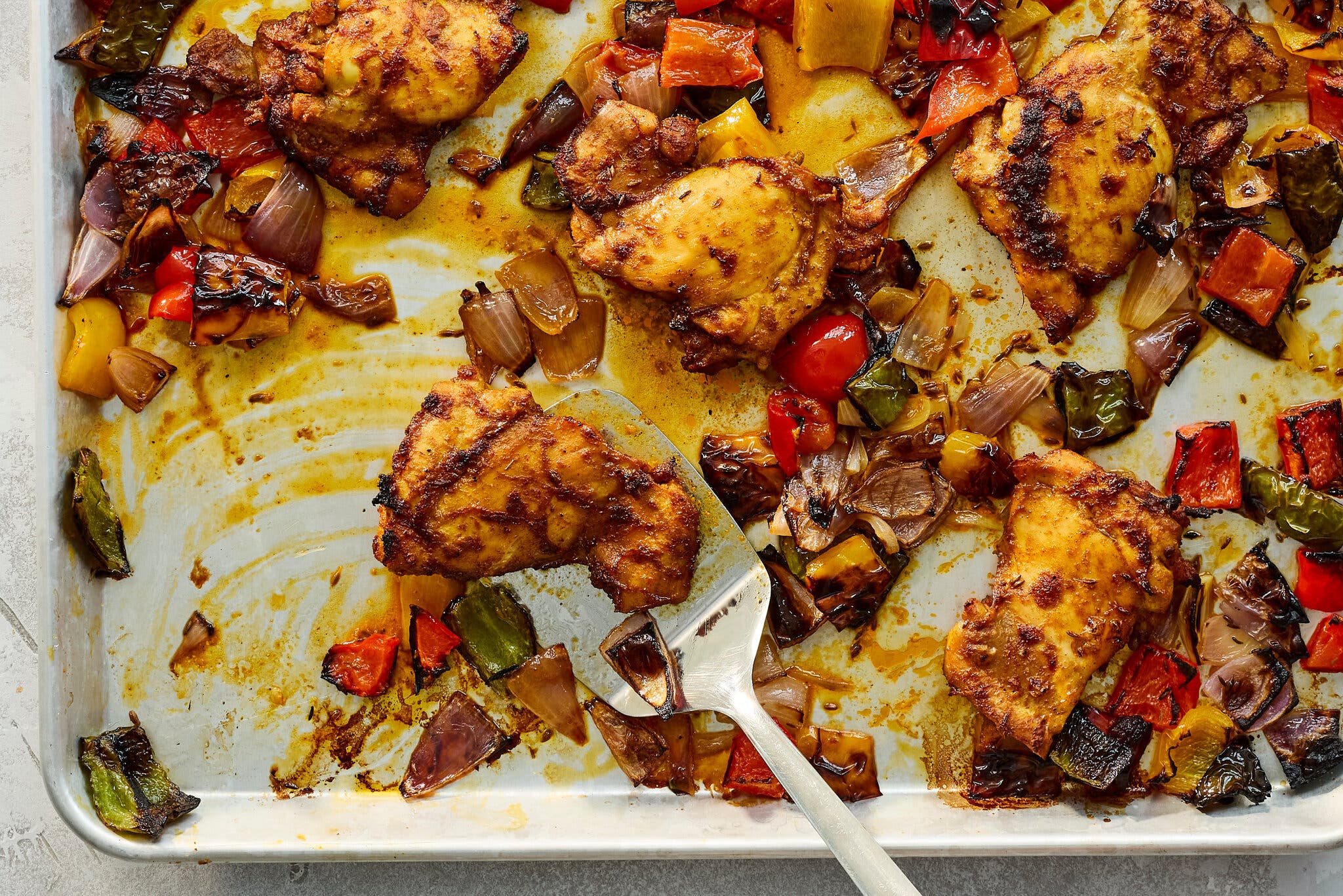
Nico Schinco for The New York Times
A sheet pan is a wide, shallow baking pan made from aluminum or stainless steel whose low sides encourage airflow and browning. A kitchen workhorse, it’s the go-to pan for roasting vegetables, meats and often entire meals. If you don’t already have one (or several) in your cupboard, here are some considerations before you buy.
Most sheet pans are 18-by-13 inches with a 1-inch rim. Sometimes called half-sheet pans, they are half the size of those found in commercial kitchens, which are too big for most home ovens. In this guide, we’ll use the 18-by-13-inch pan as our standard, though the quarter sheet pan, measuring about 9-by-13 inches, is terrific for smaller ovens or kitchens as well as for cooking several ingredients in the oven at once without letting the flavors bleed into one another.
You can choose a pan that’s either aluminum or stainless steel, but whatever you choose look for a pan with a heavy-duty gauge — this refers to the thickness of the metal used. The higher the gauge, the thinner the pan: Anything from 13 to 18 gauges will work well.
Wirecutter, a product recommendations website owned by The New York Times Company, has a guide to the best baking sheets.
Correction: An earlier version of this article described incorrectly the correlation between a metal’s thickness and its gauge. The higher the gauge, the thinner — not thicker — the metal is.
Every satisfying sheet-pan meal, like the most well-rounded dinners, is built around a protein. Whether you decide on poultry, beef, pork, fish or tofu, you’ll want to start with ¼ to ¾ pound per serving, to be supplemented with vegetables.
When cooking poultry, bear in mind that dark meat takes longer to cook than white meat, and bone-in chicken longer than boneless. Timing can vary, from 5 minutes for chicken or turkey breast tenders run under the broiler, to 1½ hours for bone-in turkey legs.
Chicken Cook Times
All times are for skin-on chicken in a 400-degree oven.
Whole chicken breast, bone-in: 30 to 40 minutes
Whole chicken breast, boneless: 20 to 30 minutes
Whole chicken thighs, bone-in: 30 to 45 minutes
Whole chicken thighs, boneless: 25 to 40 minutes
Protein in hand, it’s time to pick the vegetables that’ll round out your meal. How many, and how much, are up to you. But remember that vegetables cook down significantly under high temperatures, so always err on the side of more.
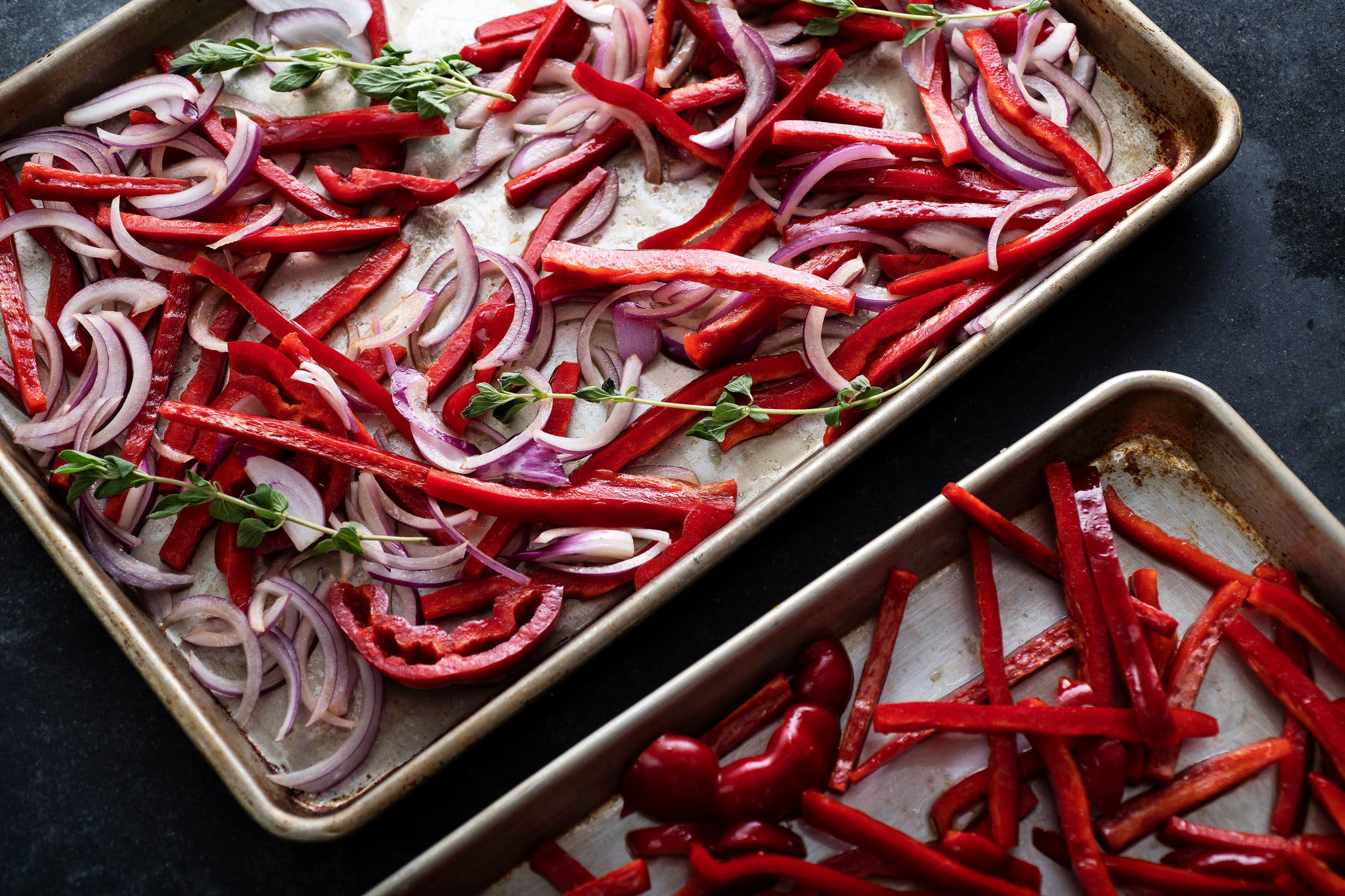
Karsten Moran for The New York Times
When working with vegetables, make sure they’re cut consistently. Just as you did with your protein, you’ll want to coat them with an oil or fat and any herbs or spices of your choosing, giving them plenty of space on the pan to encourage browning.
Dense vegetables — potatoes, radishes, winter squashes — take the longest to cook, 30 minutes to 2 hours, depending on oven temperature and chunk size. Vegetables with a higher moisture content can take less time, 10 to 45 minutes. However if you’re looking to caramelize vegetables with a very high moisture content — zucchini and tomatoes in particular — it can take longer because the moisture needs to evaporate before browning can occur. Roasting at a high temperature, 425 to 450 degrees, can speed things up.
Leafy vegetables — kale, broccoli rabe, bok choy, chard — will cook fastest, 3 to 10 minutes. If the leaves are thoroughly dry, they will turn crisp and brown. Kale and chard can turn to brittle and chiplike if you use enough oil.
Popular vegetables and their suggested cooking times
All vegetables are cut into ½-inch chunks, unless specified,
and cooked in a 400-degree oven
Asparagus, whole: 8 to 15 minutes, depending on thickness
Beets: 25 to 40 minutes
Bell peppers: 30 to 45 minutes
Broccoli: 10 to 15 minutes
Brussels sprouts, halved: 20 to 30 minutes
Butternut, or winter, squash: 25 to 40 minutes
Cauliflower: 25 to 45 minutes
Carrots, cut into ½-inch chunks, left whole or halved lengthwise: 30 to 45 minutes
Cherry tomatoes, whole: 25 to 50 minutes for caramelized
Chickpeas, canned: 40 to 55 minutes for crisp
Eggplant: 25 to 45 minutes
Leeks: 20 to 35 minutes
Potatoes: 25 to 35 minutes
Sweet potatoes: 30 to 40 minutes
Zucchini or summer squash: 40 to 55 minutes
Once you’ve chosen your main ingredients, you could, of course, leave well enough alone, but you can also get creative with the seasonings. Fat, herbs, spices and garnishes all add to the character of the finished dish.
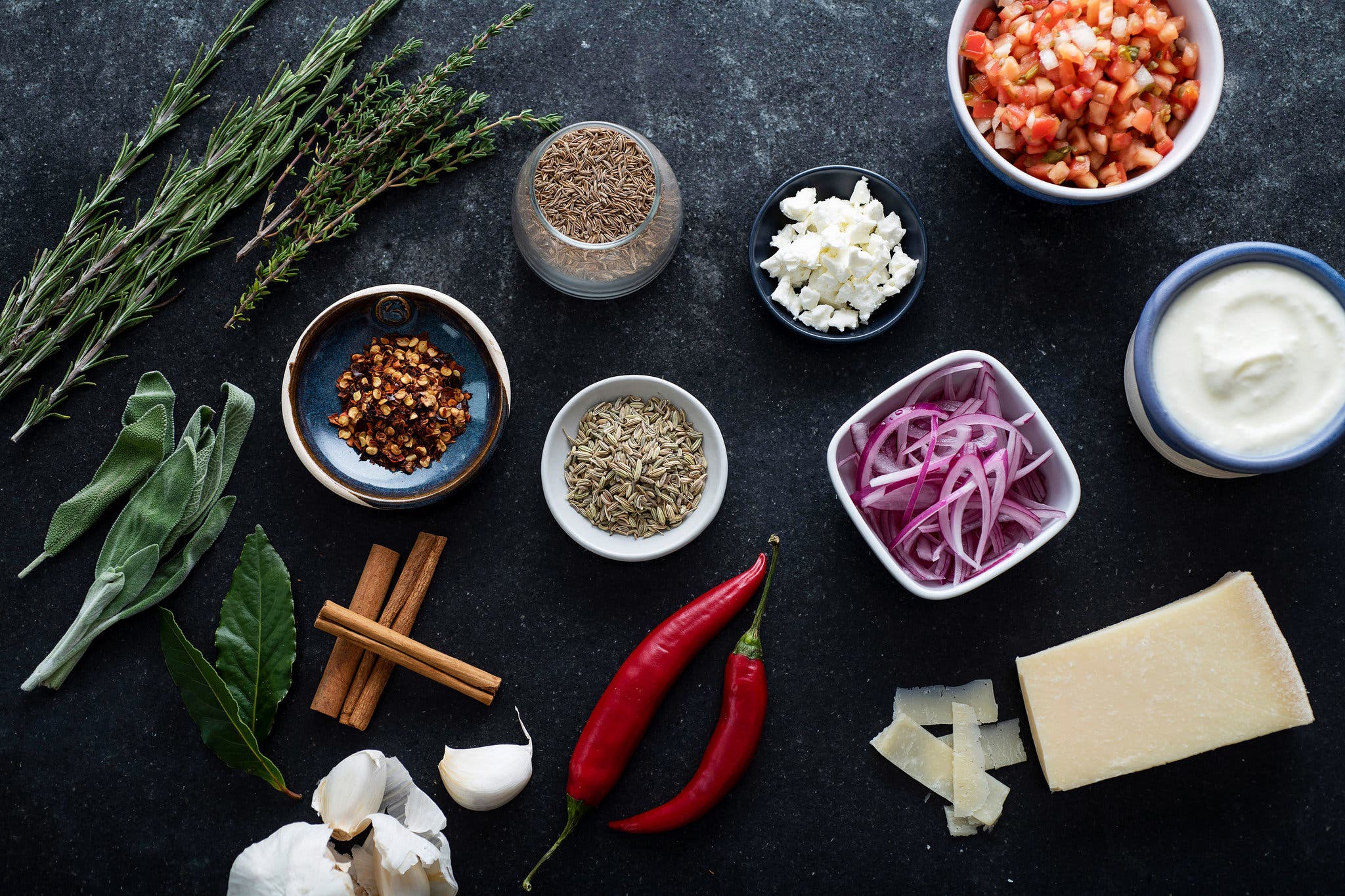
Karsten Moran for The New York Times
Fat
Fat encourages browning and helps evenly cook the ingredients on your sheet pan. Olive oil is the classic choice, but other oils and fats, like coconut oil, peanut oil, duck fat and leftover bacon grease, all add distinct flavors. For something more neutral, look to sunflower, grapeseed and canola. Simply toss ingredients with enough fat so they are lightly coated.
Herbs and Spices
Sprigs of sturdy, branchy fresh herbs can stand up to lengthy cooking without burning. Thyme, lemon thyme, oregano, marjoram, rosemary, bay leaves, tarragon and sage are all good choices; just throw them on the pan with the other ingredients. Dried herbs and herb mixes like Herbs de Provence are excellent added to a marinade, paste or rub.
Avoid soft herbs like basil, chives, parsley, cilantro and mint, which can turn brown at high heat. They’re better as garnishes.
Whole spices can also be tossed directly onto the pan with the other ingredients, adding fragrance and depth. Some favorites include chile flakes, coriander seeds, fennel seeds, cumin seeds and cinnamon sticks. Use ground spices and spice blends in marinades, pastes and rubs.
Bold Additions …
Whole smashed garlic cloves (peeled or unpeeled); slivered, blanched lemons; and whole or sliced fresh chiles can be added with the other ingredients, and will turn wonderfully brown while roasting. Make sure they are well coated with oil or fat to encourage caramelization. Note that peeled garlic will add a more intense flavor than unpeeled.
… And Bright Finishes
Consider fresh soft herbs, squeezes of citrus or drizzles of vinegar, yogurt, vinaigrettes, grated or crumbled cheeses, salsas, sauces, chutneys, relishes, quick-pickled onions or shallots, chile pastes and hot sauces. All add vibrancy to a finished dish.
You have your protein and vegetables, and you’ve considered your flavors. What remains should be as simple as coating your ingredients in fat and adding seasonings and roasting, but there are a few more things to bear in mind.
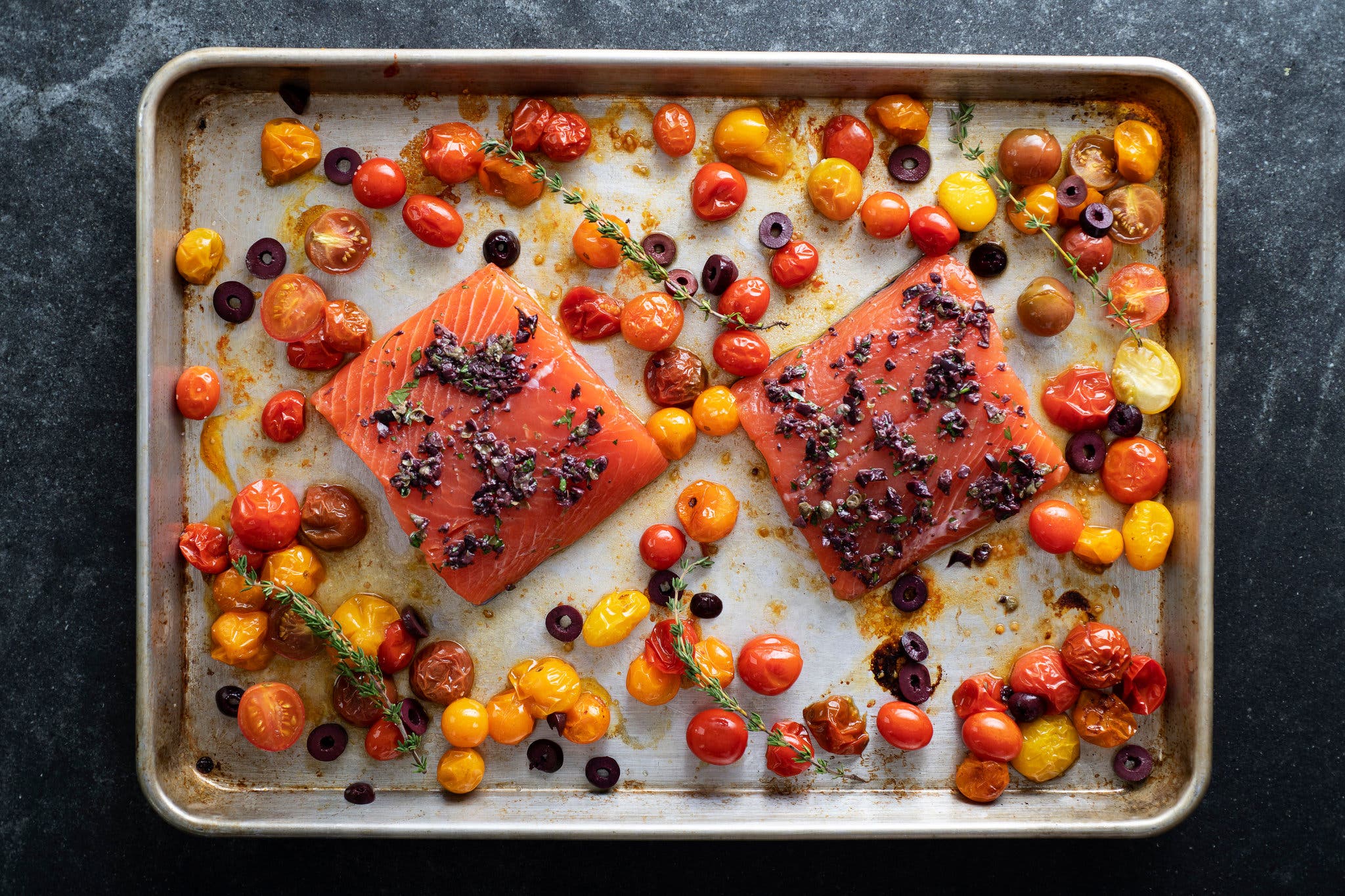
Karsten Moran for The New York Times
Your ingredients — and their cook times — matter. It should go without saying that different ingredients cook at different times. Start with the slowest-cooking ingredient, then add items in a progression, ending with whatever cooks fastest.
So does cut. The smaller an ingredient is chopped, the faster it will cook. This applies only to like ingredients: Small chunks of carrots may still take longer to cook through than larger pieces of tomatoes, mushrooms, broccoli or other less dense vegetables. Half an inch is a good starting point, cooking quickly while providing a satisfying bite.
Pay attention to placement, both of your sheet pan and your ingredients. The closer the sheet pan is to the heat source, the crisper and browner everything will get. Similarly, ingredients at the pan’s edges cook faster than those in the middle. (Take note, too, that the more spread out the ingredients are, the more air will flow between them, browning them further.) For even cooking, place larger pieces at the edges and smaller pieces in the center, and make sure to rotate your sheet pan halfway through cooking.
Mind your temperature. The suggested cook times listed here are based on a 400-degree oven temperature, but choose a hotter temperature for deeper color and a juicy center, and a lower temperature for slower, more even cooking. You can also run quick-cooking ingredients under the broiler for a meal in minutes. It’s also worth noting that a higher temperature browns food faster, so you’ll want to keep a more careful watch. Setting the temperature a little lower gives you more wiggle room.
If you still find yourself seeking inspiration, here are four meals that began with just the basics, and evolved into something impressive in a few simple steps.
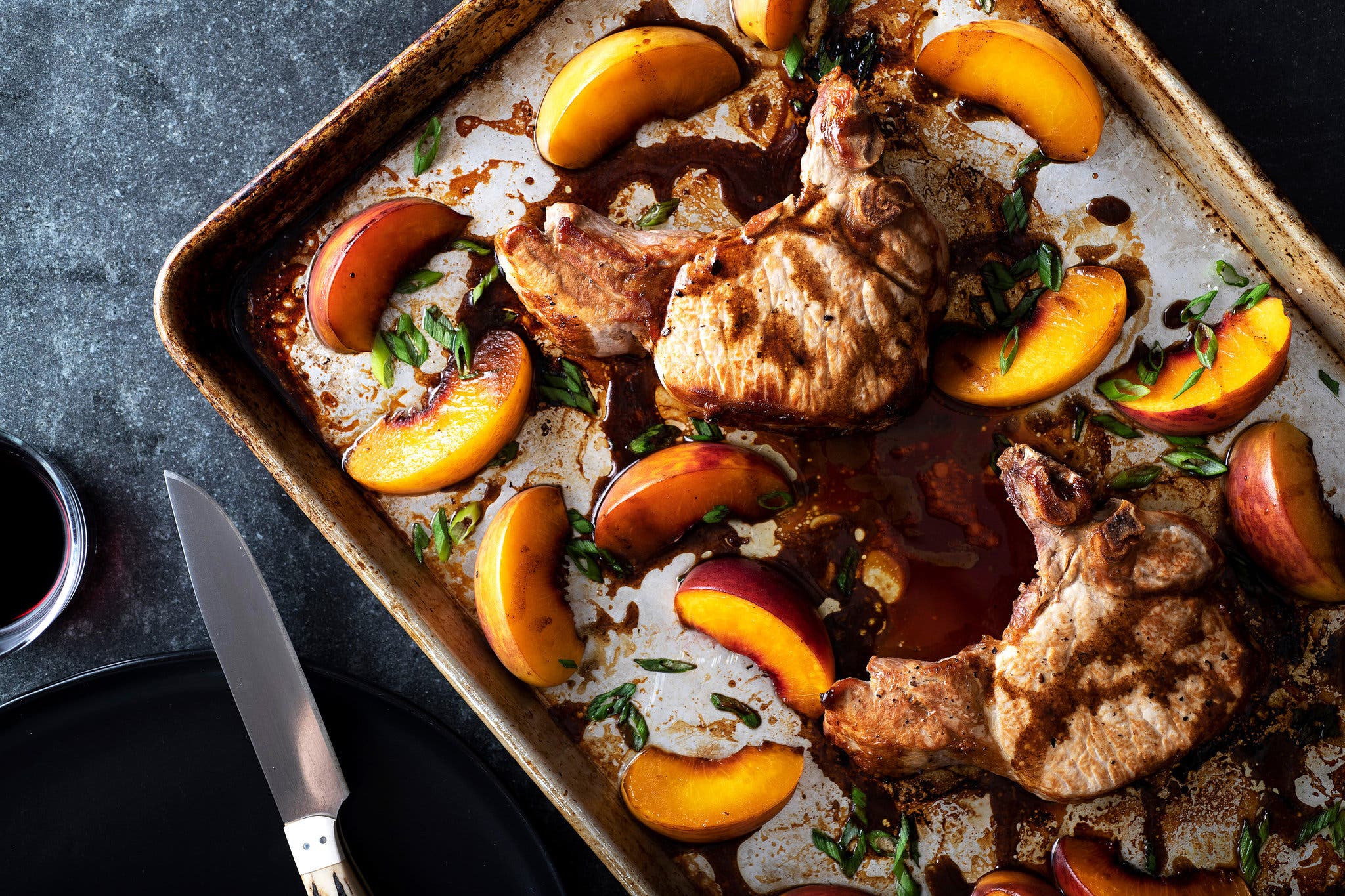
Karsten Moran for The New York Times
Pork Chops and Peaches
Basic: Roast 1-inch-thick pork chops surrounded by sliced peaches at 450 degrees for 12 to 18 minutes.
Upgraded: Sear pork chops on both sides under broiler before adding peaches and then roast at 450 degrees for 12 to 18 minutes.
Elegant: Sear pork chops on both sides under broiler before adding peaches and then roasting at 450 degrees for 12 to 18 minutes. After chops and peaches have roasted for 10 minutes, add some thinly sliced scallions.
Impressive: Sear pork chops on both sides under broiler before adding peaches and then roasting, roast at 450 degrees for 12 to 18 minutes. After chops and peaches have roasted for 10 minutes, add thinly sliced scallions to pan. Drizzle chops with a mix of pomegranate molasses and olive oil before serving.
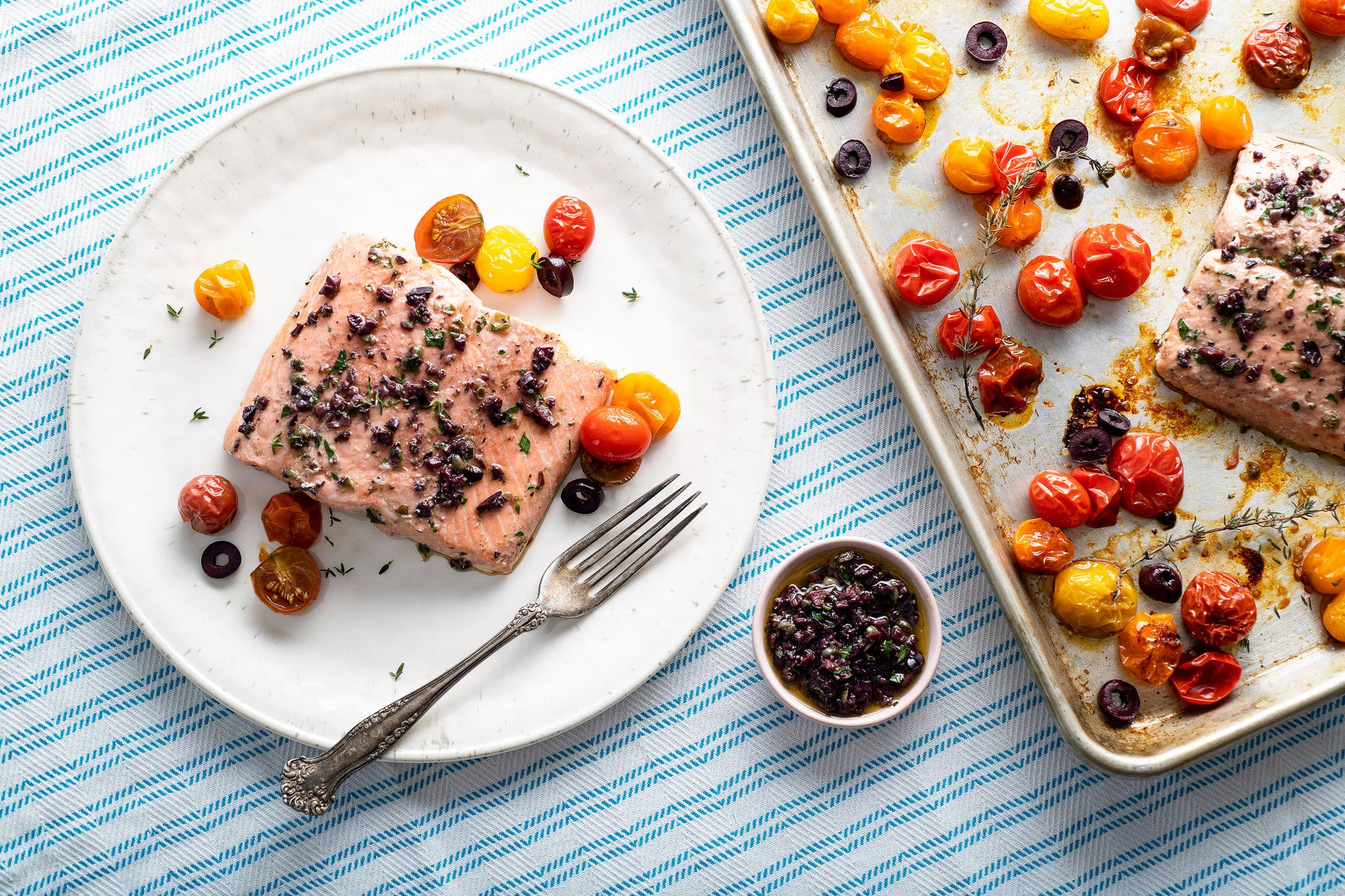
Karsten Moran for The New York Times
Salmon and Cherry Tomatoes
Basic: Roast salmon filets surrounded by halved cherry tomatoes at 400 degrees for 10 minutes.
Upgraded: Roast halved cherry tomatoes at 400 degrees for 20 minutes, to caramelize them. Add salmon filets to pan. Cook salmon and tomatoes for another 10 minutes.
Elegant: Roast halved cherry tomatoes at 400 degrees for 20 minutes, to caramelize them. Add salmon filets to pan, along with sliced olives and thyme branches. Cook everything for another 10 minutes.
Impressive: Roast halved cherry tomatoes at 400 degrees for 20 minutes, to caramelize them. Brush salmon with tapenade, and add salmon to pan, along with sliced olives and thyme branches. Cook everything for another 10 minutes.
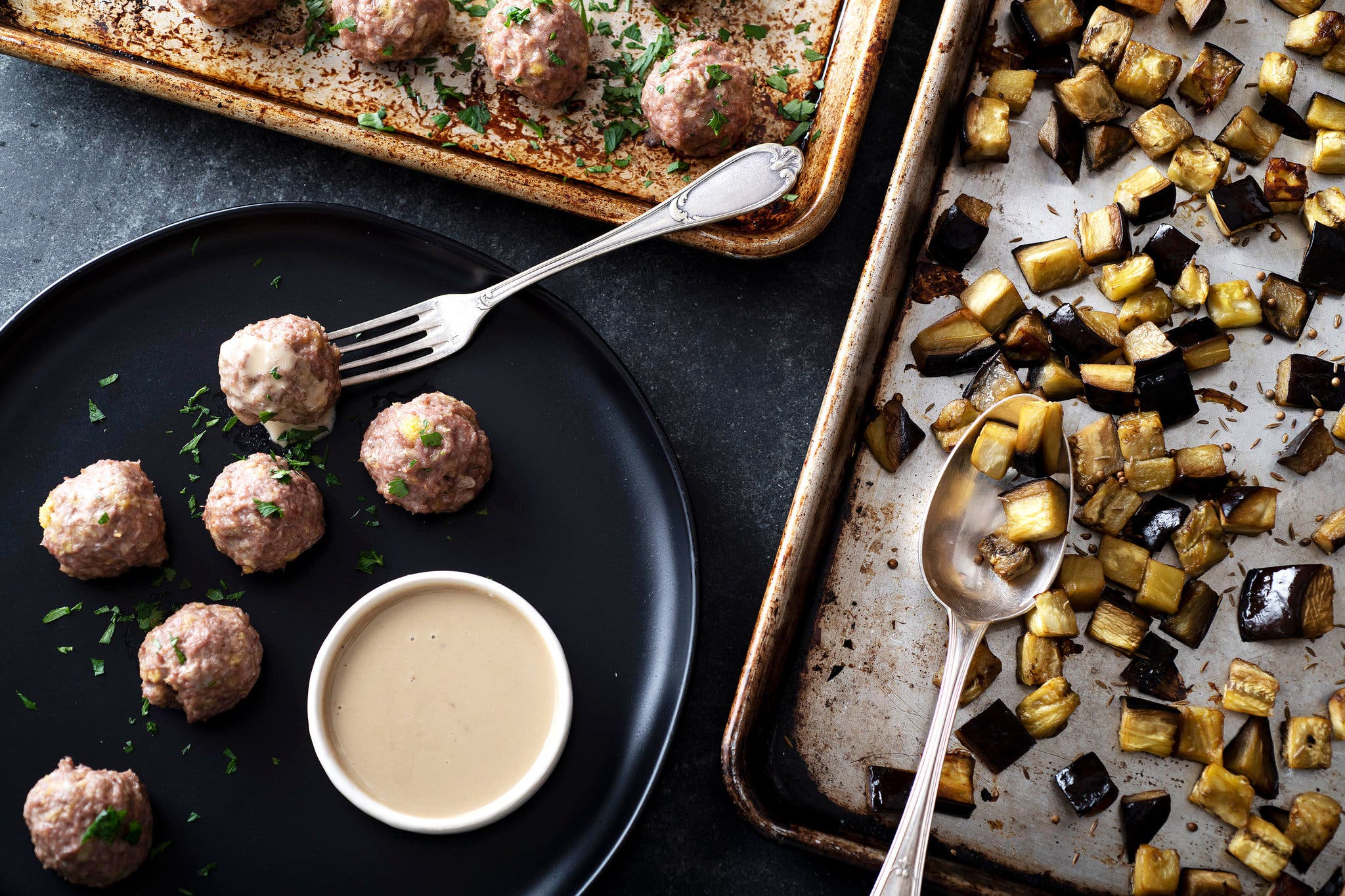
Karsten Moran for The New York Times
Meatballs and Red Chiles
Basic: Roast 1½-inch lamb or beef meatballs with thinly sliced red chiles all over pan at 425 degrees for 10 to 15 minutes.
Upgraded: Ten minutes before putting the meatballs in the oven, place a second sheet pan of ¾-inch pieces of eggplant in the oven. Roast meatballs and chiles, as instructed, and pull both the meatballs and eggplant out at the same time.
Elegant: Ten minutes before putting the meatballs in the oven, place a second sheet pan of ¾-inch pieces of eggplant, sprinkled with cumin and coriander seeds, in the oven. Roast meatballs and chiles, as instructed, and pull both the meatballs and eggplant out at the same time.
Impressive: Ten minutes before putting the meatballs in the oven, place a second sheet pan of ¾-inch pieces of eggplant, sprinkled with cumin and coriander seeds, in the oven. Roast meatballs and chiles, as instructed, and pull both the meatballs and eggplant out at the same time. Serve with tahini-garlic sauce for dipping.
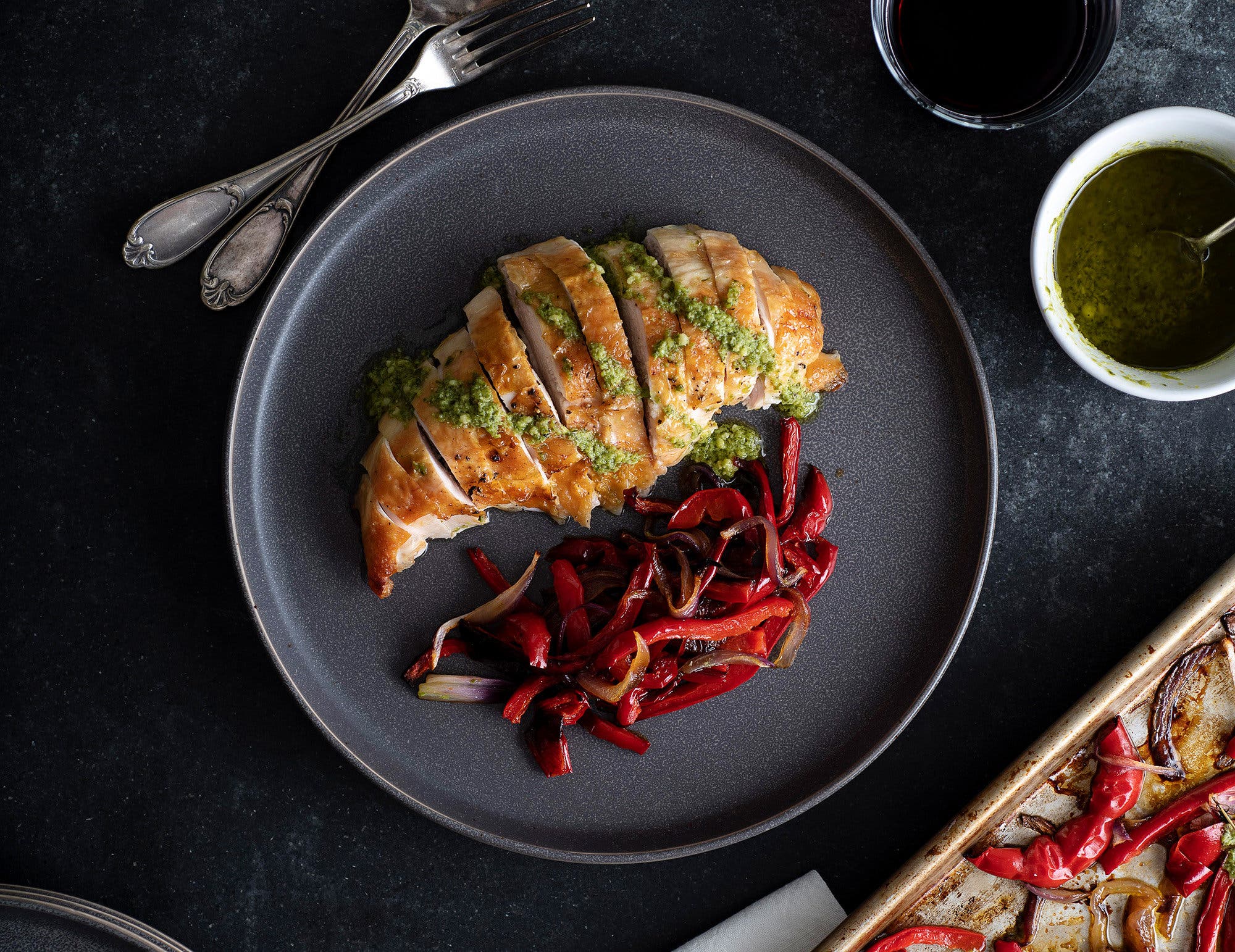
Karsten Moran for The New York Times
Chicken and Bell Peppers
Basic: Roast bone-in, skin-on chicken breasts on a bed of thinly sliced bell peppers at 425 degrees for 25 to 30 minutes.
Upgraded: Roast bone-in, skin-on chicken breasts on a bed of thinly sliced bell peppers, thinly sliced red onion and fresh oregano sprigs at 425 degrees for 25 to 30 minutes.
Elegant: Marinate chicken breasts with some garlic, cumin, lemon zest and fresh oregano. Roast bone-in, skin-on chicken breasts on a bed of thinly sliced bell peppers, thinly sliced red onion and fresh oregano sprigs at 425 degrees for 25 to 30 minutes.
Impressive: Marinate chicken breasts with some garlic, cumin, lemon zest and fresh oregano. Roast bone-in, skin-on chicken breasts on a bed of thinly sliced bell peppers, thinly sliced red onion and fresh oregano sprigs at 425 degrees for 25 to 30 minutes. Serve with a dressing made from pesto thinned with lemon juice and olive oil.





